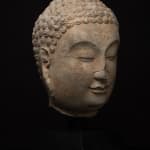Sui Stone Head of a Buddha, 581 CE - 618 CE
Stone
height 29.2 cm
height 11 1/2 in
height 11 1/2 in
HK.2032
Further images
-
(View a larger image of thumbnail 1
)

-
(View a larger image of thumbnail 2
)

-
(View a larger image of thumbnail 3
)

-
(View a larger image of thumbnail 4
)

-
(View a larger image of thumbnail 5
)

-
(View a larger image of thumbnail 6
)

-
(View a larger image of thumbnail 7
)

-
(View a larger image of thumbnail 8
)

This is a stone sculpture of the head of a Bodhisattva. Peacefully gazing downwards, the figure has a serene facial expression, radiating an approachable and amiable aura. The eyebrows are...
This is a stone sculpture of the head of a Bodhisattva. Peacefully gazing downwards, the figure has a serene facial expression, radiating an approachable and amiable aura. The eyebrows are longer and the distribution of facial features is more spacious and relaxed. From the positioning of the head, it is highly plausible that it was originally a standing figure.
Standing Buddha is a prominent form of sculpture under the patronage of the Northern Wei imperial family, who commissioned the carving of rock caves in Longmen and Gongxian, both in Henan province, in the first quarter of the 6th century, which typically show seated or standing Buddhas flanked by two bodhisattvas. Besides these massive stone carvings in cave temples, many free-standing steles, also often with two bodhisattva figures on either side of a central Buddha statue, were commissioned in that century, which followed the artistic language introduced by these grand Buddhist cave sculpture projects, which exerted an overwhelming influence on Chinese sculpture of the period in general.
The head belongs to a mature phase of Sui artistic production, when craftsmen synthesized styles from within and beyond China into graceful yet dynamic compositions that expressed the transcendental majesty of the Buddhist subject, diversifying the visual vocabulary of each region of the empire, while preserving established characteristics in production. Thus, this sculpture embodies the stylistic transition from the Northern Dynasties to Tang Dynasty.
Standing Buddha is a prominent form of sculpture under the patronage of the Northern Wei imperial family, who commissioned the carving of rock caves in Longmen and Gongxian, both in Henan province, in the first quarter of the 6th century, which typically show seated or standing Buddhas flanked by two bodhisattvas. Besides these massive stone carvings in cave temples, many free-standing steles, also often with two bodhisattva figures on either side of a central Buddha statue, were commissioned in that century, which followed the artistic language introduced by these grand Buddhist cave sculpture projects, which exerted an overwhelming influence on Chinese sculpture of the period in general.
The head belongs to a mature phase of Sui artistic production, when craftsmen synthesized styles from within and beyond China into graceful yet dynamic compositions that expressed the transcendental majesty of the Buddhist subject, diversifying the visual vocabulary of each region of the empire, while preserving established characteristics in production. Thus, this sculpture embodies the stylistic transition from the Northern Dynasties to Tang Dynasty.







